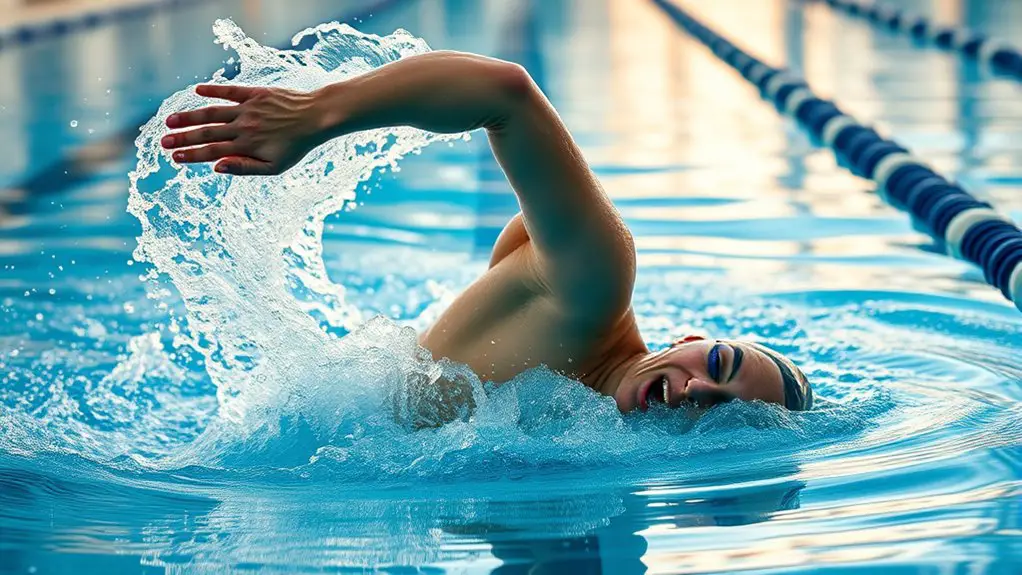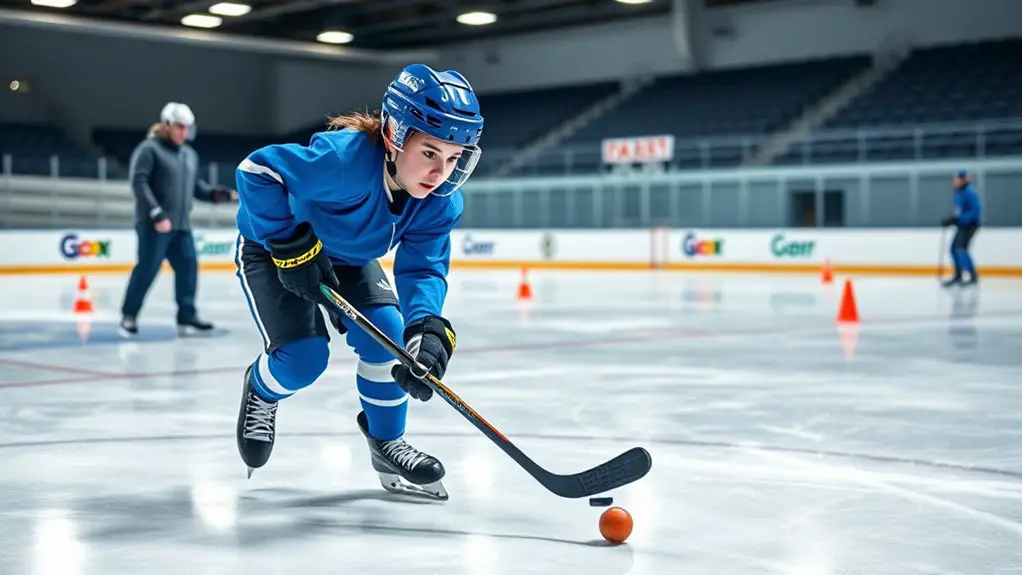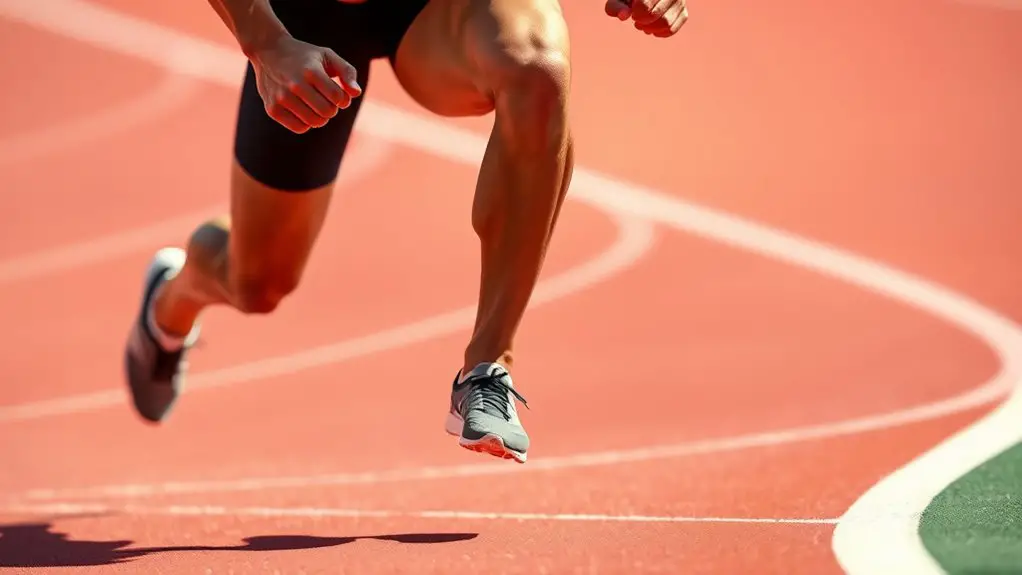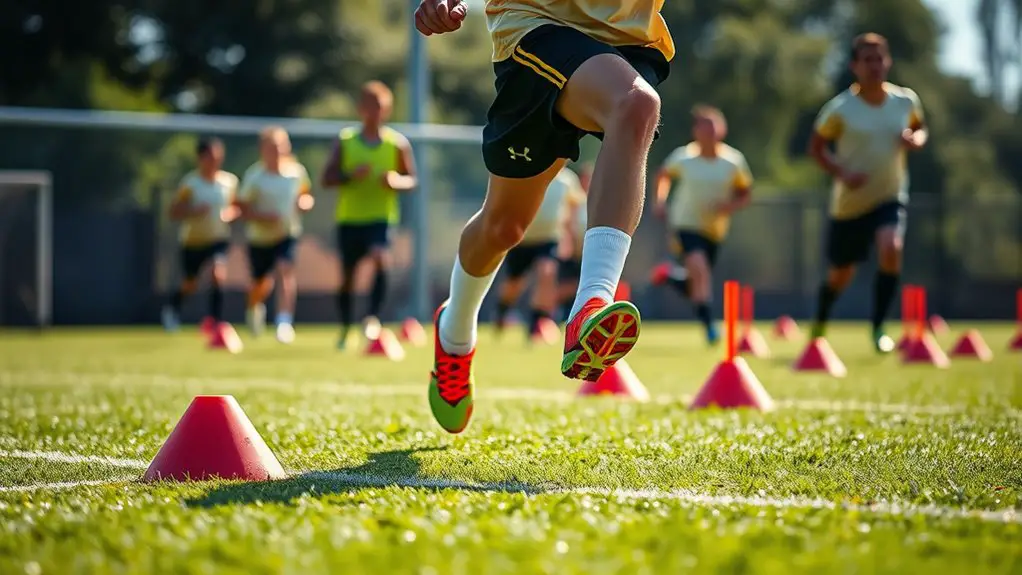To improve your flip turn technique for faster changes, focus on smooth movements and proper body positioning. Tuck your chin and knees to speed up your rotation, and keep your hips and shoulders aligned for balance. Practice isolated drills for mechanics, and incorporate underwater kicks for power. Avoid common mistakes like poor body position and timing errors. Set achievable goals to track progress, and soon you'll uncover more tips to enhance your technique even further.
Understanding the Basics of Flip Turns
When you're mastering flip turns, it's crucial to understand the fundamental mechanics behind them. The flip turn fundamentals are all about smooth, fluid motion. You want to embrace the freedom of movement, allowing your body to flow effortlessly as you approach the wall. Start by positioning yourself correctly and getting into the right mindset. As you near the wall, initiate the somersault mechanics by tucking your chin and bringing your knees to your chest. This compact position helps you rotate faster, making it easier to flip into your next stroke seamlessly.
Think about your body as a coiled spring, ready to release power and speed. Remember, the more you practice these mechanics, the more natural they'll feel. Mastering these basics isn't just about technique; it's about feeling liberated in the water, gliding through your changes with confidence and ease. Staying properly hydrated before and during your practice can significantly enhance your focus and energy levels, which are vital for executing perfect flip turns.
Key Components of a Successful Flip Turn
To master a successful flip turn, you'll need to focus on a few key components. Body positioning and alignment are essential, along with timing your somersault perfectly. Don't forget about a streamlined push-off technique to maximize your speed as you shift back into the water.
Body Positioning and Alignment
Mastering body positioning and alignment is essential for executing a successful flip turn. To achieve ideal body alignment, keep your head in line with your spine while tucking your chin slightly. This helps maintain a streamlined form, reducing drag as you approach the wall. As you initiate the turn, focus on achieving rotational balance by engaging your core and using your arms to guide your movement. Your hips should rotate in unison with your shoulders, creating a fluid motion that enhances efficiency. Remember, the tighter your body is during the flip, the faster your change will be. Embrace the freedom of movement and practice these positioning techniques to elevate your flip turn game!
Timing Your Somersault
Achieving the right timing for your somersault is essential for executing a smooth flip turn. You want to initiate your flip just as you approach the wall, allowing your body to naturally roll into the somersault. Focus on your somersault timing; it's all about feeling that moment when your feet connect with the wall. As you push off, make sure your rotation speed is just right—not too fast to lose control, and not too slow to waste momentum. Practice this timing repeatedly to find the sweet spot that feels instinctive. Remember, the more you refine your flip turn, the more freedom you'll have in the water, leading to quicker changes and enhanced performance in your swim.
Streamlined Push-Off Technique
Once you've executed a precise flip turn, your next focus should be on a streamlined push-off technique. This step is essential for maximizing your speed and efficiency in the water. To achieve a successful push-off, keep these key components in mind:
- Streamlined Body: Position your body into a tight, elongated shape, minimizing drag as you glide.
- Push Off Angle: Angle your feet slightly downward upon leaving the wall, allowing for a smooth, powerful entry into your underwater phase.
- Core Engagement: Activate your core muscles to maintain stability and control as you shift from the wall.
Drills to Enhance Your Flip Turn Technique
To enhance your flip turn technique, incorporating specific drills into your practice routine can make a significant difference. Start with basic drill variations, like practicing your flip turn without the swim portion. Focus on the mechanics of the turn itself—execute a tight tuck and make sure your hands enter the water first. Next, incorporate underwater kicks after your push-off. This'll help build your power and streamline your shift.
Try performing repeated flip turns while counting your underwater kicks, aiming for a consistent count each time. This'll not only improve your kick strength but also help you feel the rhythm of your shifts. Finally, consider using a kickboard to isolate your underwater kicks, allowing you to refine your technique without worrying about your upper body. By making these drills a regular part of your training, you'll see significant improvements in your flip turn efficiency and speed, giving you that freedom to glide through the water.
Common Mistakes to Avoid
While mastering the flip turn, it's easy to fall into common pitfalls that can hinder your performance. Recognizing these common errors is the first step toward a smoother changeover. Here are three technique pitfalls to avoid:
- Poor Body Position: If your body's not streamlined, you'll create unnecessary drag. Keep your core tight and your body aligned.
- Timing Missteps: Don't rush the turn. Inadequate timing can lead to a chaotic flip, slowing you down instead of speeding you up.
- Lack of Coordination: Your arms and legs need to work together. If they're out of sync, you risk losing momentum and balance.
How to Practice Flip Turns Effectively
When it comes to practicing flip turns, incorporating specific drills can make a big difference in your technique. You might also find that using video analysis helps you spot areas for improvement. Plus, working with a partner can provide valuable feedback and make the process more effective.
Drills for Flip Turns
Practicing flip turns effectively requires a combination of specific drills that focus on body position, timing, and coordination. To enhance your flip turn technique, try these drill variations:
- Wall Turns: Push off the wall, execute a flip turn, and focus on maintaining a streamlined body position as you glide.
- Resistance Training: Use fins or a resistance band to strengthen your legs and core, improving your power and control during turns.
- Timed Turns: Set a timer for short sprints, incorporating flip turns at the wall. This builds speed and helps you practice quick shifts.
Video Analysis Techniques
How can video analysis elevate your flip turn technique? By capturing your flips on camera, you get a unique chance for a detailed video breakdown. This allows you to see exactly what's working and what needs improvement. Watch your body position, timing, and rotation—those subtle tweaks can make a huge difference in your speed and efficiency.
As you review the footage, focus on technique refinement; identify areas where you might be losing momentum or balance. This self-awareness empowers you to make adjustments that feel right for you. Plus, you can compare your flips to those of skilled swimmers, gaining insight into their strategies. Embrace this freedom to learn and grow, and watch your flip turns transform!
Partner Practice Sessions
Video analysis can provide invaluable insights, but nothing beats hands-on practice with a partner. When you team up, you get instant feedback and a boost of mutual motivation. Here's how to make the most of your partner practice sessions:
- Observe and Feedback: Take turns performing flip turns while your partner watches closely. Share tips on technique and areas to improve.
- Set Goals Together: Establish specific targets for each practice, like reducing time or perfecting form. Keeping goals in mind keeps you both focused and driven.
- Switch Roles: Don't just critique; practice giving and receiving feedback. This builds trust and helps you learn from each other's strengths.
With partner practice, you'll refine your flip turns while enjoying the journey together!
Incorporating Flip Turns Into Your Swim Sets
Incorporating flip turns into your swim sets can greatly enhance your overall performance and efficiency in the water. By seamlessly integrating flip turn drills into your training, you'll not only build muscle memory but also improve your changes. Here's a simple way to structure your sets:
| Swim Set | Duration | Flip Turn Drill |
|---|---|---|
| Warm-Up | 10 mins | Basic Flip Turns |
| Main Set | 20 mins | 50s with Flip Turns |
| Cool Down | 10 mins | Easy Swim with Turns |
During your main set, focus on executing the flip turns with precision. This swim set integration will allow you to adapt to the rhythm of your strokes while mastering your turns. Remember, the more you practice, the more natural it'll feel, giving you the freedom to swim faster and more efficiently. Enjoy the process!
Tips for Maintaining Speed After the Turn
While mastering flip turns is essential, maintaining your speed after the turn is equally important for optimizing your swim performance. Here are three tips for achieving speed maintenance and enhancing shift efficiency:
- Streamline Position: As you push off the wall, keep your body tight and streamlined. This reduces drag and maximizes your speed.
- Kick Hard: Use a powerful dolphin kick to propel yourself forward. Strong kicks help you maintain momentum as you break the surface.
- Smooth Shift to Stroke: Don't rush into your stroke. Gradually transition from the push-off to your swimming technique, ensuring a fluid motion that retains speed. Additionally, incorporating mobility training can enhance your flexibility and efficiency, further supporting your performance in the water.
Tracking Progress and Setting Goals for Improvement
After mastering your flip turn and maintaining speed off the wall, the next step is to track your progress and set goals for improvement. Start by recording your times and noting how your flip turn feels during practice. This isn't just about numbers; it's about understanding your growth and identifying areas that need attention. Use a journal or an app for effective goal tracking.
Set specific, achievable goals for each practice. For instance, aim to reduce your flip turn time by a certain fraction or improve your technique on every third lap. Regular progress monitoring will keep you motivated and provide a clear path forward. Celebrate small victories along the way—they're essential for maintaining your enthusiasm. Embrace the journey, and don't hesitate to adjust your goals as you improve. Remember, it's not just about speed; it's about enjoying the freedom of swimming more efficiently. Additionally, cultivating a growth mindset will help you view challenges as opportunities for improvement and foster resilience in your training.
Frequently Asked Questions
What Is the Ideal Body Position During a Flip Turn?
The ideal body position during a flip turn's all about maintaining proper body alignment. You want your head tucked and your hips high, creating a streamlined shape. As you initiate the rotational movement, keep your core tight and legs together. This helps you pivot smoothly and prevents drag. Stay relaxed but controlled—you'll find that freedom in your motion makes the turn feel effortless, allowing for faster changes and a more enjoyable swimming experience.
How Can Breathing Technique Affect Flip Turns?
Breathing technique plays an essential role in your flip turns. If you can maintain a steady breathing rhythm, it'll help you stay calm and focused during the turn. Perfecting your air control allows you to minimize disruptions as you flip, making the shift smoother. When you're relaxed and in control of your breath, you'll find that you can execute your turns with greater efficiency, leading to faster shifts and more freedom in the water.
Should I Use Fins While Practicing Flip Turns?
Using fins while practicing flip turns can feel like both a blessing and a curse. On one hand, fins provide benefits like increased propulsion and improved body position, making training drills more effective. On the other hand, relying too much on them might hinder your natural technique. It's crucial to strike a balance; fins can help you gain confidence, but don't forget to practice without them for true freedom in your swimming style.
Can Flip Turns Be Practiced Without a Pool?
You can definitely practice flip turns without a pool! Dryland drills can help you strengthen your core and improve your body positioning. Incorporate visualization techniques to mentally rehearse the movements and shifts. Picture yourself executing the turn flawlessly, feeling that rush of freedom. While nothing beats the water, these methods can keep your skills sharp and build confidence, so you're ready to plunge in when you hit the pool next.
What Type of Swim Suit Is Best for Flip Turns?
When choosing the best swimsuit for flip turns, you'll want to focus on suit material and suit fit. A suit made from chlorine-resistant fabric provides durability, while a snug fit guarantees you won't experience drag during your turns. Look for styles that offer flexibility and comfort, allowing you to move freely. Avoid overly loose suits, as they can hinder your performance. Ultimately, the right swimsuit can make a significant difference in your swimming experience.




